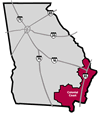
Wildlife Viewing Guide


|
Wildlife Viewing Guide |
 |
 Jekyll
Island Causeway & Jointer Creek
Jekyll
Island Causeway & Jointer Creek
Description: The causeway to Jekyll cuts through open marsh and mud flats. The area is influenced by tidal waters, with two high tides and two low tides in every day. Spartina grass dominates the saltmarsh vegetation. The Causeway itself has a more diverse plant cover, including wax myrtle, sea ox-eye, marsh elder, and the exotic pink and white oleander, which constitutes an outstanding habitat for marsh rabbits and a variety of other small mammals. At low tide the marsh mud and exposed oyster beds create unique foraging habitats for a wide variety of birds. The Jointer Creek mud flats are seen at low tide exactly 1.8 miles south of the Causeway on US Hwy. 17.
Viewing Information: The Jekyll Island Causeway and Jointer Creek mud flats are good viewing sites for a variety of birds throughout the year. At high tides, the Jekyll Causeway is a good place to see shore and wading birds loafing on the exposed "salt pan" marsh flats situated along the south side of the causeway wherever the grass is sparse. Many different birds can be seen on the wires and telephone poles along the way. Red-tailed hawks, kestrels, osprey, and peregrine falcons can be seen in the fall and winter months. Late October and early November are good times to see flocks of several thousand tree swallows feeding on wax myrtle berries along the causeway. The nearby Jointer Creek mud flats is the most likely site in Georgia to see roseate spoonbills between July and September. It is also a spot to see wood storks, great egrets, and great blue herons during warm weather. This site should be visited during a period of about two hours before or after low tide. Deep silt mud provides good feeding for long-legged birds. Diamondback terrapins can be seen crossing roads between April and July.
Directions: From Brunswick, travel south on US Hwy. 17. Cross the Sidney Lanier Bridge and turn left onto the Jekyll Island Causeway.
Management: Georgia Department of Transportation.
Closest Town: Brunswick, GA
Additional Information: Both the Causeway and US Hwy. 17 present hazards to wildlife viewing because of fast-moving traffic. Caution must be employed, especially when children are present. Binoculars and/or a spotting telescope are highly recommended.
Read and add comments about this page